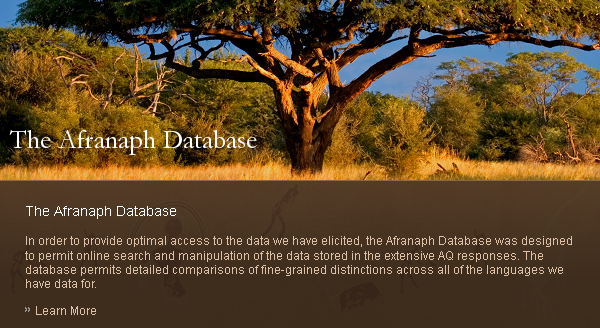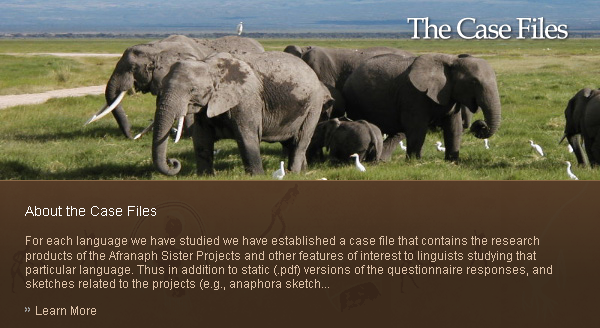- Last Updated on Tuesday, 29 December 2020 05:39
![]()
Afranaph Glossing Conventions – Revised September, 2016
This is a list of the most commonly used glosses in the Afranaph database. The glosses follow the general guidelines of the Leipzig Glossing Rules [http://www.eva.mpg.de/lingua/resources/glossing-rules.php]
Content words are glossed with the best-guess English translation. All conventional glosses should be drawn from the list below, although departures from standard notation have sometimes been judged appropriate by consultants and/or analysts in order to convey relevant language-specific information. Words are separated by spaces on original text, morpheme breakdown and gloss lines. A single morpheme in the morpheme breakdown is bounded on either side by an empty space (at the beginning or end of a word) or by a dash or dashes if it is word internal, and if an indivisible morpheme expresses a combination of glosses, then the glosses corresponding to the single morpheme are separated by a period, as in the example below.
| English: | Bill saw girls |
| Bill saw girl-s | |
| Bill see.PST girl-PL |
At various points we diverge from the Leipzig glosses either because they are not available for certain kinds of morphemes, they are not specific enough for certain kinds of distinctions, or they are not distinct enough to allow for optimal searches in the database. We expect that we will add to this list or reassign some glosses from time to time, as long as no data is lost or misrepresented as a result.
| Gloss | Meaning | Usage note |
| 1st | 1st person | |
| 2nd | 2nd person | |
| 3rd | 3rd person | |
| ACC | Accusative | Amharic |
| AGR | Agreement | When a more specific term like OM or SM is not used |
| AGT | Agent or Agentive | |
| AM | Associative marker | Urhobo, cf. Urhobo AQR |
| APPL | Applicative | |
| ASP | Aspect | |
| BEN | Benefactive | |
| CAUS1 | Causative affix | |
| CAUS1 | Long causative affix | Cf. Hyman (2003), Good (2006) |
| CAUS2 | Short causative affix | Cf. Hyman (2003), Good (2006) |
| CJ | Conjoint | |
| CL | Noun class marker | Where no noun class number is available |
| COMP | Complementizer | |
| COND | Conditional | |
| CONJ | Conjunction | |
| CPL | Centripetal | Indicates the event involves motion toward the subject |
| cX2 | Noun class prefix for class X | Where X = some number |
| DEFAGR | Default Agreement | |
| DET | Determiner | |
| DJ | Disjoint | |
| ERL | Affix meaning the event was early | See use in Eegimaa |
| EXCL | Exclusive | |
| F | Feminine | |
| FMR | Former/used to | See use in Eegimaa |
| FUT3 | Future | |
| FV | Final vowel | |
| GEN | Genitive | |
| HAB | Habitual | |
| HUM | Human | Where the human/non-human distinction has exponents |
| IMPV | Imperative | |
| ICV | Inclusive | Where the distinction is used for 1st and 2nd plural |
| INF | Infinitive | |
| IPFV | Imperfective | |
| IRM | Inherent reflexive marker (verbal affix) | When there is an exponent |
| IRR | Irrealis | |
| LOC | Locative | |
| M | Masculine | |
| MALF | Malefactive | |
| MID | Middle voice | Ikalanga, Kirundi |
| NEG | Negation |
|
| NML4 | Nominal | Where there exists nominalizers |
| NOM | Nominative | |
| OBJ | Amharic: Object agreement | |
| Lokaa: Objective case | ||
| OM | Object marker (verbal affix) | |
| OPT | Optative | |
| PART | Partitive | |
| PASS | Passive | |
| PFV | Perfective | |
| PL | Plural | |
| POSS | Possessive | |
| PRN | Pronominal | |
| PROG | Progressive | |
| PRS | Present | |
| PST5 | Past | |
| RCM | Reciprocal marker | Reciprocal verbal affix |
| RECP6 | Reciprocal (not a verbal affix) | |
| RED | Reduplication | |
| REFL7 | Reflexive (not a verbal affix) | |
| REL | Relative | |
| REP | Repetitive | |
| REV | Reversative | |
| RFM | Reflexive marker | Reflexive verbal affix |
| RLS8 | Realis | |
| RS | Lexical reciprocal base | Amharic |
| SBJ | Subject agreement | Amharic |
| SBJV | Subjunctive | |
| SG | Singular | |
| SM | Subject marker | Verbal affix, Bantu-specific notation |
| TM | Tense marker | When no more specific gloss is possible |
| TAM | Tense aspect marker | When no more specific gloss is possible |
| TNS | Tense | When no more specific gloss is possible |
| WHAGR | Wh-agreement |
|
Further notes
1 CAUS: The distinction between CAUS, CAUS1 and CAUS2 is included because there are Bantu phenomena of particular interest in this respect. Searching for CAUS will find all three glosses, but the distinction between CAUS1 and CAUS2 is included because many Bantu languages have two affixes that have been characterized (by some) as causative, although their effects differ in interesting ways (and ways that interact with patterns of anaphora). In languages where both affixes are present, we have classified them according to morphological and (to a lesser degree) semantic effects that distinguish them. For languages that have only one causative affix, CAUS is used exclusively.
2 cX: This is why we do not just use ‘1’, ‘2’ and ‘3’ for person glosses. If our users want to search for c3 nouns and agreement, there is no confusion with ‘3rd’, but more importantly, if one is searching for 1st, searching for ‘1’ would bring up both noun class and person tokens.
3 FUT: In languages that have temporally distinct future morphemes, FUT is distinguished as FUT1 (temporally closest to PRS), FUT2 (next temporally closest)…FUTn. Many Bantu languages have such systems.
4 NML: This is suitable both for nominalizing morphemes such as the Yoruba 'i-' or noun class markers as in Baatonum and other languages with class markers.
5 PST: In languages that have temporally distinct past morphemes, PST is distinguished as PST1 (temporally closest to PRS), PST2 (next temporally closest)…PSTn. Many Bantu languages have such systems.
6 RECP: This is almost never used in our database because the argument position markers that are interpreted as reciprocals are almost always roots that have other meanings outside of reciprocal contexts. We are particularly interested in the morphological and semantic properties of distinct forms of reciprocal marking. See the fn. on REFL.
7 REFL: Many markers that are interpreted as reflexive are not glossed with REFL because we are particularly interested in the morphological and semantic properties of distinct forms of reflexive marking. We only use REFL when the morpheme in question is not a verb affix and has no other meaning in another use in the language, e.g., when a reflexive argument consists of a pronoun compounded with a root that means ‘body’, the gloss is PRN-BODY, or in some cases, the capitalized morphology of the root in the language (particularly when more than one root can for a reflexive argument).
8 RLS: For example, Jóola Eegima has an exponent for realis, but none for irrealis.




 Glossing Conventions
Glossing Conventions
